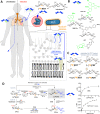This is a preprint.
Distributable, Metabolic PET Reporting of Tuberculosis
- PMID: 37333343
- PMCID: PMC10274857
- DOI: 10.1101/2023.04.03.535218
Distributable, Metabolic PET Reporting of Tuberculosis
Update in
-
Distributable, metabolic PET reporting of tuberculosis.Nat Commun. 2024 Jun 27;15(1):5239. doi: 10.1038/s41467-024-48691-6. Nat Commun. 2024. PMID: 38937448 Free PMC article.
Abstract
Tuberculosis remains a large global disease burden for which treatment regimens are protracted and monitoring of disease activity difficult. Existing detection methods rely almost exclusively on bacterial culture from sputum which limits sampling to organisms on the pulmonary surface. Advances in monitoring tuberculous lesions have utilized the common glucoside [18F]FDG, yet lack specificity to the causative pathogen Mycobacterium tuberculosis (Mtb) and so do not directly correlate with pathogen viability. Here we show that a close mimic that is also positron-emitting of the non-mammalian Mtb disaccharide trehalose - 2-[18F]fluoro-2-deoxytrehalose ([18F]FDT) - can act as a mechanism-based enzyme reporter in vivo. Use of [18F]FDT in the imaging of Mtb in diverse models of disease, including non-human primates, successfully co-opts Mtb-specific processing of trehalose to allow the specific imaging of TB-associated lesions and to monitor the effects of treatment. A pyrogen-free, direct enzyme-catalyzed process for its radiochemical synthesis allows the ready production of [18F]FDT from the most globally-abundant organic 18F-containing molecule, [18F]FDG. The full, pre-clinical validation of both production method and [18F]FDT now creates a new, bacterium-specific, clinical diagnostic candidate. We anticipate that this distributable technology to generate clinical-grade [18F]FDT directly from the widely-available clinical reagent [18F]FDG, without need for either bespoke radioisotope generation or specialist chemical methods and/or facilities, could now usher in global, democratized access to a TB-specific PET tracer.
Conflict of interest statement
Competing interests: The authors report no competing interests.
Figures







References
-
- WorldHealthOrganization. Global Tuberculosis Report 2021. (Geneva (Switzerland), 2021).
-
- TheInternationalAtomicEnergyAuthority. IAEA Medical imAGIng and Nuclear mEdicine (IMAGINE) <https://humanhealth.iaea.org/HHW/DBStatistics/IMAGINE.html. > (
Publication types
Grants and funding
LinkOut - more resources
Full Text Sources
